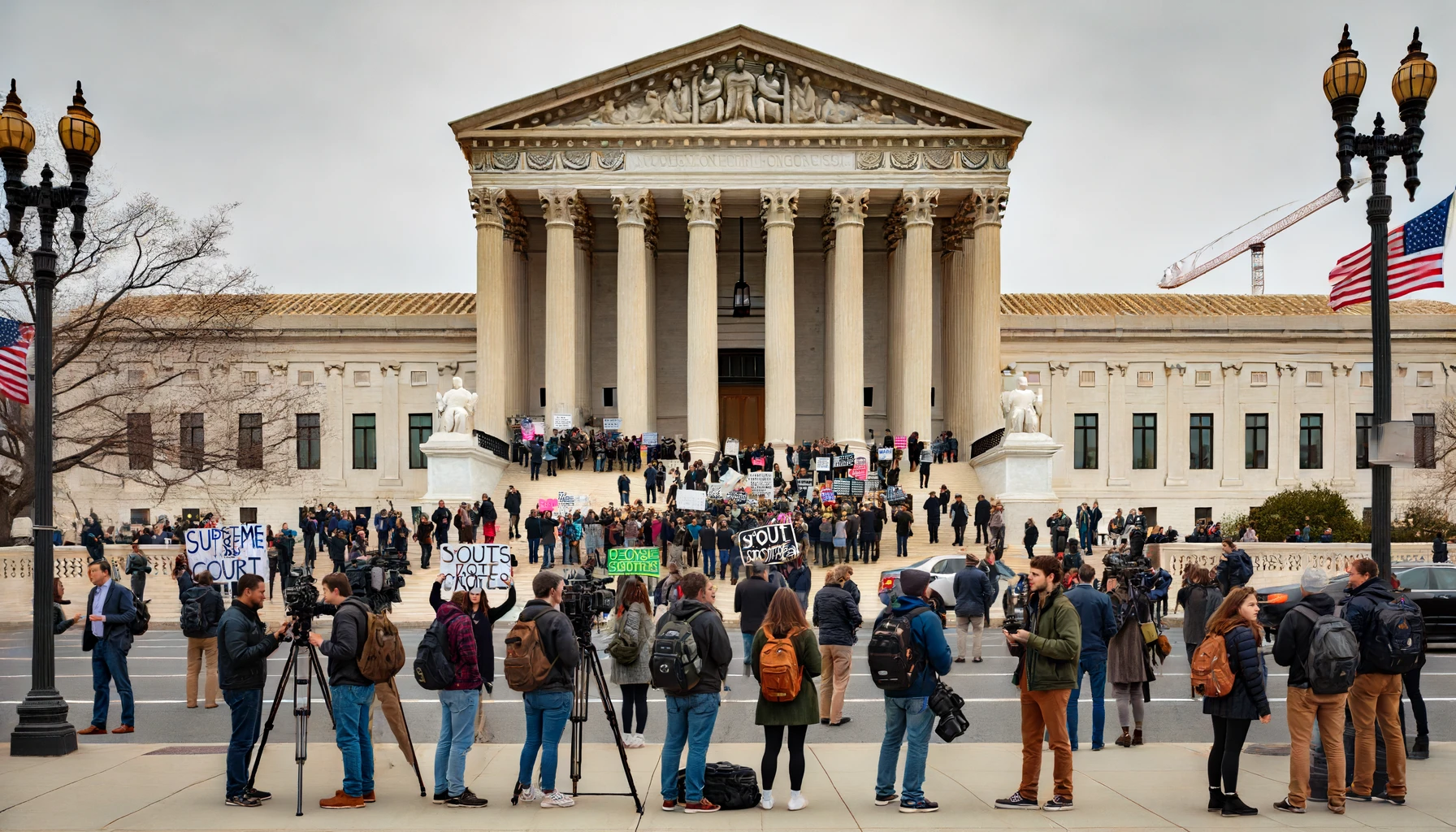On June 14, 2024, the U.S. Supreme Court struck down a federal ban on bump stocks, devices that allow semi-automatic rifles to fire rapidly like machine guns. This 6-3 decision, along ideological lines, has significant implications for gun regulations and highlights ongoing debates about administrative power and gun control in the United States.
Background on Bump Stocks and the Ban
Bump stocks became a focal point of national debate following the 2017 mass shooting in Las Vegas. The gunman used rifles equipped with bump stocks to fire more than 1,000 rounds in 11 minutes, killing 60 people and injuring hundreds. This tragic event remains the deadliest mass shooting in modern U.S. history. The outcry from this incident led to significant political pressure to ban bump stocks. In December 2018, the Trump administration enacted a ban on these devices, classifying them as machine guns under the National Firearms Act of 1934 and the Gun Control Act of 1968. The ban required owners to destroy or surrender their bump stocks by March 2019, with penalties including prison time for those who failed to comply.
Supreme Court’s Ruling
Justice Clarence Thomas, writing for the majority, found that the Bureau of Alcohol, Tobacco, Firearms, and Explosives (ATF) had overstepped its authority by issuing a rule that classified bump stocks as machine guns. He stated, “We hold that a semiautomatic rifle equipped with a bump stock is not a ‘machine gun’ because it cannot fire more than one shot ‘by a single function of the trigger.’”
The ruling pointed out that bump stocks do not change the basic mechanics of how a gun fires, which is crucial for the classification of a machine gun under federal law. Justice Thomas included several diagrams to illustrate how bump stocks work, emphasizing that they do not allow a firearm to fire automatically with a single trigger pull.
Justice Samuel Alito, in a concurring opinion, stressed that while the Las Vegas shooting was tragic, it did not change the statutory text or its meaning. He indicated that it is Congress’s responsibility to amend the law if they want to include bump stocks under the definition of machine guns.
Dissenting Opinion
Justice Sonia Sotomayor, joined by Justices Elena Kagan and Ketanji Brown Jackson, filed a dissenting opinion. Sotomayor argued that the court’s ruling could have deadly consequences by allowing devices that enable rapid firing back into civilian hands. She criticized the majority for an “artificially narrow definition” of machine guns. “When I see a bird that walks like a duck, swims like a duck, and quacks like a duck, I call that bird a duck,” Sotomayor wrote, drawing an analogy to argue that bump stocks should be classified as machine guns due to their functionality.

Reactions and Implications
President Joe Biden condemned the decision, calling it a significant setback for gun safety. He urged Congress to ban bump stocks and pass other gun control measures, including an assault weapon ban. “Americans should not have to live in fear of this mass devastation,” Biden stated.
Gun rights advocates celebrated the ruling. Michael Cargill, a Texas gun shop owner who challenged the ban, and Mark Chenoweth, president of the New Civil Liberties Alliance, which represented Cargill, welcomed the decision. Chenoweth stated, “The statute Congress passed did not ban bump stocks, and ATF does not have the power to do so on its own.”
Broader Context
The ruling is part of a broader trend where the Supreme Court has expanded gun rights. In recent years, the court has struck down various gun control measures, arguing they infringe on Second Amendment rights. Notably, this case focused on administrative authority rather than directly on the Second Amendment. The decision underscores the contentious role of administrative agencies in interpreting and enforcing laws, a significant legal debate in the United States.
The ruling also reflects deep political divisions. Democrats generally support stricter gun regulations, while Republicans often oppose them. The case’s outcome illustrates the challenges and complexities of enacting effective gun safety regulations in a politically divided environment.
This article is based on the following articles:
https://apnews.com/article/supreme-court-guns-bump-stocks-b3bd1b4163d78514a6d5acc5b44c8b3d
https://www.nytimes.com/2024/06/14/us/politics/supreme-court-trump-gun-bump-stocks.html

Background Information
The Supreme Court of the United States
The Supreme Court is the highest court in the United States. It consists of nine justices who serve lifetime appointments. The Court has the final say on interpreting the Constitution and federal law, making its decisions critical to the country’s legal and social fabric. Justices are nominated by the President and confirmed by the Senate. The Court’s decisions can have wide-ranging impacts on American society.
The National Firearms Act of 1934 and the Gun Control Act of 1968
The National Firearms Act (NFA) of 1934 was one of the first major federal gun control laws in the United States. It was enacted in response to gang violence during Prohibition and primarily targeted the types of firearms favored by criminals at the time, such as machine guns and sawed-off shotguns. The Act imposes a tax on the manufacture and transfer of these firearms and requires registration of all NFA firearms.
The Gun Control Act (GCA) of 1968 was passed after the assassinations of President John F. Kennedy, Senator Robert F. Kennedy, and Dr. Martin Luther King Jr. It focuses on regulating interstate commerce in firearms by generally prohibiting interstate firearms transfers except among licensed manufacturers, dealers, and importers. The GCA also expanded the NFA’s definition of a machine gun to include any device that can convert a firearm into a machine gun.
Bump Stocks
A bump stock is a device that can be attached to a semi-automatic rifle. It allows the weapon to fire rapidly, mimicking the rate of fire of a fully automatic machine gun. Bump stocks use the recoil of the firearm to “bump” the trigger back and forth against the shooter’s finger, allowing for rapid firing without the need for a fully automatic mechanism.
The 2017 Las Vegas Shooting
The 2017 Las Vegas shooting, also known as the Route 91 Harvest festival shooting, is the deadliest mass shooting committed by an individual in modern U.S. history. On October 1, 2017, Stephen Paddock, a 64-year-old man, opened fire from the 32nd floor of the Mandalay Bay Hotel on a crowd attending a country music festival. He used rifles equipped with bump stocks, which allowed him to fire over 1,000 rounds in about 11 minutes, killing 60 people and injuring hundreds more. This incident brought national attention to bump stocks and sparked debates about gun control and public safety.
The Trump Administration’s Ban on Bump Stocks
In response to the Las Vegas shooting, the Trump administration took steps to ban bump stocks. In December 2018, the Bureau of Alcohol, Tobacco, Firearms, and Explosives (ATF) reinterpreted federal law to classify bump stocks as machine guns, making their sale and possession illegal. This ban required current owners to destroy or surrender their bump stocks by March 2019. The ban was seen as a significant regulatory step towards addressing gun violence, although it faced legal challenges.
The Role of the Bureau of Alcohol, Tobacco, Firearms, and Explosives (ATF)
The ATF is a federal agency within the U.S. Department of Justice. It enforces federal laws related to alcohol, tobacco, firearms, explosives, and arson. The ATF is responsible for regulating the firearms industry and investigating crimes involving firearms and explosives. The agency’s decision to classify bump stocks as machine guns was based on its authority to interpret and enforce firearms regulations.
Judicial Review and Administrative Power
Judicial review is the process by which courts interpret the constitutionality of legislative and executive actions. In the case of the bump stock ban, the Supreme Court’s review centered on whether the ATF exceeded its authority by reinterpreting the definition of a machine gun to include bump stocks. The balance of power between administrative agencies (like the ATF) and the legislative branch (Congress) is a critical aspect of American governance. Administrative agencies are given authority by Congress to implement and enforce laws, but their power is not unlimited and can be challenged in court.
The Second Amendment
The Second Amendment to the U.S. Constitution protects the right of the people to keep and bear arms. This amendment is often at the center of debates on gun control. Supporters of gun rights argue that the Second Amendment guarantees an individual’s right to own and carry firearms. Advocates for gun control argue that reasonable regulations are necessary to ensure public safety. The Supreme Court has made several landmark rulings on the Second Amendment, impacting how gun laws are interpreted and enforced.
The Role of the Supreme Court in Gun Rights
The Supreme Court has a significant influence on the interpretation of the Second Amendment and gun laws. Key decisions include:
- District of Columbia v. Heller (2008): The Court held that the Second Amendment protects an individual’s right to possess a firearm, unconnected with service in a militia, and to use that arm for traditionally lawful purposes, such as self-defense within the home.
- McDonald v. City of Chicago (2010): The Court ruled that the Second Amendment is incorporated by the Due Process Clause of the Fourteenth Amendment and is therefore applicable to the states.
- New York State Rifle & Pistol Association Inc. v. Bruen (2022): The Court struck down New York’s law requiring a special need to carry a concealed handgun in public, further expanding gun rights.
Impact of the Ruling
The Supreme Court’s decision to overturn the bump stock ban has several implications:
- Legal Precedents: The ruling may set a precedent for future cases involving administrative interpretations of federal law, particularly related to gun regulations.
- Gun Control Legislation: The decision may prompt Congress to consider new legislation to address the regulation of bump stocks and other firearms accessories.
Public Safety Concerns: The ruling has sparked debates about public safety and the effectiveness of current gun control measures in preventing mass shootings and reducing gun violence.

Debate/Essay Questions
- Do you believe that bump stocks should be classified as machine guns under federal law? Why or why not?
- How does the political affiliation of Supreme Court justices influence their decisions on cases involving gun control?
Please subscribe to Insight Fortnight, our biweekly newsletter!
